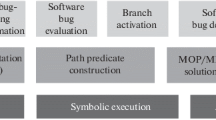Abstract
We present here a careful exploration of the set of instructions for the x86 processor architecture. This is a preliminary step towards a systematic comparison of SMT-based retro-engineering tools. The latter arose in the context of binary code retro-engineering. All these tools rely themselves on more elementary disassembly tool. In this contribution, we attack the problem at its most atomic level: the instructions. We prepare, trading off between the size of the list and the correctness of the future comparison, a good list of instructions.
G. Bonfante—Experiments have been conducted at LHS - LORIA.
A. Talon—Supported by DGA - Direction Générale de l’Armement.
Access this chapter
Tax calculation will be finalised at checkout
Purchases are for personal use only
Similar content being viewed by others
Notes
- 1.
- 2.
- 3.
- 4.
- 5.
- 6.
More technical details can be found in http://ref.x86asm.net/coder32.html.
References
Intel 64 and IA-32 Architectures Software Developer Manuals. https://software.intel.com/content/www/us/en/develop/articles/intel-sdm.html
Girol, G., Farinier, B., Bardin, S.: Not all bugs are created equal, but robust reachability can tell the difference. In: Silva, A., Leino, K.R.M. (eds.) CAV 2021, Part I. LNCS, vol. 12759, pp. 669–693. Springer, Cham (2021). https://doi.org/10.1007/978-3-030-81685-8_32
Mahoney, W., McDonald, J.T.: Enumerating x86-64 - it’s not as easy as counting. https://www.unomaha.edu/college-of-information-science-and-technology/research-labs/_files/enumerating-x86-64-instructions.pdf
Salwan, J., Bardin, S., Potet, M.-L.: Symbolic deobfuscation: from virtualized code back to the original. In: Giuffrida, C., Bardin, S., Blanc, G. (eds.) DIMVA 2018. LNCS, vol. 10885, pp. 372–392. Springer, Cham (2018). https://doi.org/10.1007/978-3-319-93411-2_17
Saudel, F., Salwan, J.: Triton: a dynamic symbolic execution framework. In: Symposium sur la sécurité des technologies de l’information et des Communications, pp. 31–54 (2015)
Shoshitaishvili, Y., et al.: SoK: (State of) the art of war: offensive techniques in binary analysis. In: IEEE Symposium on Security and Privacy (2016)
Souchet, A., Girault, É.: Taming a wild nanomite-protected MIPS binary with symbolic execution: No such crackme. https://doar-e.github.io/blog/2014/10/11/taiming-a-wild-nanomite-protected-mips-binary-with-symbolic-execution-no-such-crackme
Springer, J., Chang Feng, W.: Teaching with angr: a symbolic execution curriculum and CTF. In: USENIX Workshop ASE 2018 (2018)
Acknowledgments
We thank Fabrice Sabatier who gave us some examples of “nasty” instructions.
Author information
Authors and Affiliations
Corresponding author
Editor information
Editors and Affiliations
Rights and permissions
Copyright information
© 2022 Springer Nature Switzerland AG
About this paper
Cite this paper
Bonfante, G., Talon, A. (2022). At the Bottom of Binary Analysis: Instructions. In: Aïmeur, E., Laurent, M., Yaich, R., Dupont, B., Garcia-Alfaro, J. (eds) Foundations and Practice of Security. FPS 2021. Lecture Notes in Computer Science, vol 13291. Springer, Cham. https://doi.org/10.1007/978-3-031-08147-7_21
Download citation
DOI: https://doi.org/10.1007/978-3-031-08147-7_21
Published:
Publisher Name: Springer, Cham
Print ISBN: 978-3-031-08146-0
Online ISBN: 978-3-031-08147-7
eBook Packages: Computer ScienceComputer Science (R0)




